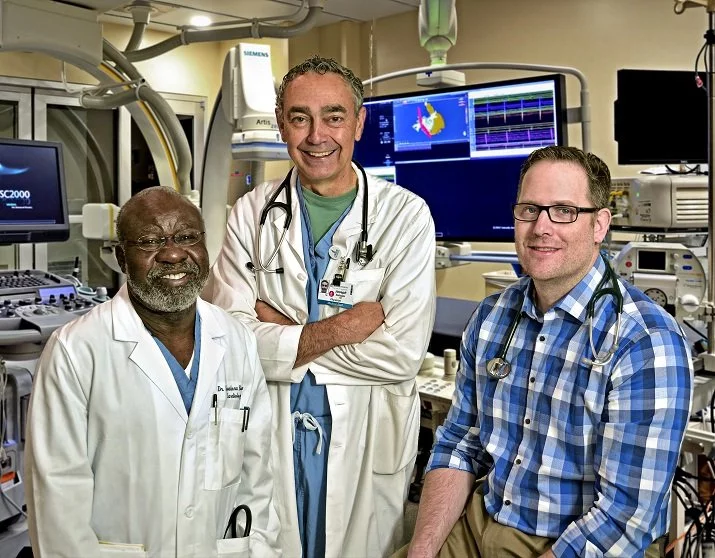Crouse First in Region to Use New Cardiovascular Device That Reduces Risk of Stroke
June 22, 2017
Home » News » Crouse First in Region to Use New Cardiovascular Device That Reduces Risk of Stroke

Crouse Health is the first hospital in Central New York to use the Watchman device, a minimally invasive implant approved by the U.S. Food and Drug Administration as an alternative to long-term blood thinner therapy for patients with atrial fibrillation (AFib), a common heart rhythm disorder.
Studies have shown that the Watchman device offers patients with AFib not related to heart valve disease as much protection from stroke as blood thinners, such as warfarin.
Crouse cardiologists Kwabena Boahene, MD, Joseph Battaglia,MD and Matthew Gorman, MD are the first in Syracuse to implant the Watchman in AFib patients.
About five million people in the United States suffer from AFib, which occurs when the upper and lower chambers of the heart stop beating in harmony. Instead, the upper chambers beat irregularly and stop moving blood through and out of the heart.
When this occurs, blood clots are likely to form in the heart’s left atrial appendage (LAA). The LAA is the size of a thumb and looks like a small pouch near the top of the heart. Blood clots can break loose from the LAA and travel to the brain, lungs and other parts of the body, causing a stroke. The Watchman implant is designed to stop clots from leaving that area of the heart.
AFib is the cause of about 20 percent of strokes, which can be devastating and costly to individuals and families, according to Joseph Battaglia, MD, FACC, medical director for Crouse’s cardiac care services. “The Watchman implant provides physicians with a breakthrough stroke risk reduction option for patients with non-valvular AFib, especially those who are poor candidates for long-term anticoagulation medication,” he says.
This new alternative to stroke-risk reduction using medication therapy involves the small, parachute-shaped device being implanted in the heart. The Watchman is implanted by accessing the heart through a vein in the leg using a non-surgical approach. The device changes the internal shape of the heart, making it resistant to clot formation, according to Dr. Battaglia.
The procedure takes one to two hours, is painless, and the majority of patients are discharged from the hospital the following day with immediate return to full function. Scar tissue forms around the device over time, permanently closing off the left atrial appendage.
